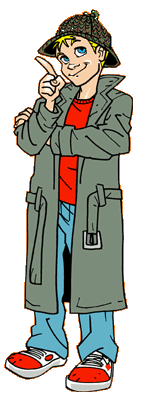STALKING SARS: CDC AT WORK
Many people helped in the fight to stop the spread of SARS. Below we highlight just some of the central figures.

Dr. Ali Khan
At the time of the SARS outbreak, Dr. Ali Khan was Associate Director of Science, Division of Parasitic Diseases, National Center for Infectious Diseases.
Dr. Khan’s MO? Follow the clues!
“I like all the questions and things we do not know about infectious diseases. It’s very interesting to take the clues from sick people and the laboratory to figure out what the disease is, and how it is probably transmitted to humans, and then try to keep anybody else from becoming sick.”
Dr. Khan works on stopping killer diseases (like malaria), and protecting the United States from them. When a new serious infectious disease (like ebola or anthrax) breaks out, he leads CDC teams that help get things under control.
Dr. Khan helped to set up a system to find people in the U.S. who had SARS, trace the disease back to see who had given it to them, and keep them from giving it to anyone else. The system worked like this… Doctors would call the health department in their state if they had a patient they suspected had SARS.
Then, the state would call the CDC with information about the patient so that the CDC had all the facts and could start tracking the disease. This info was used to create a computer database that showed all of the cases and made charts, graphs, and maps showing how the disease spread. The CDC team followed up by getting test results to make sure that the sick people actually had SARS and not something else. Fortunately, they found that SARS had not spread in the U.S. Even though there were hundreds of potential cases in the database, the lab tests showed that only eight people in the U.S. really had SARS, and all of those people got it while they were in other countries.
Dr. Khan soon got another call for help—from the WHO. They needed him to work with an international team to send CDC people to Asia to continue the investigation. After a week of helping team members prepare for their trips, Dr. Khan packed his own bags and set off for Singapore to face SARS head-on. There, he helped the Singaporean health department figure out ways to stop the disease. He also put different databases together to make one super SARS database that helped the international team working on SARS understand how the disease was spreading. On top of that, he set up research studies, wrote articles on what was going on in Singapore, put out travel warnings, and more.
Keiji Fukuda
At the time of the SARS outbreak, Keiji Fukuda was Chief of the Epidemiology Section, Influenza Branch, National Center for Infectious Diseases.
Dr. Fukuda tackles diseases that threaten every one of us.
“What I like most about my work is that disease and illness are problems for everybody— it doesn’t matter who you are, whether you’re rich or poor, or what country you come from.”
Dr. Fukuda keeps a sharp lookout for new viruses—especially flu viruses—that might cause disease to spread worldwide (called a pandemic). When CDC needed someone to check out the mystery disease firsthand, they knew he was the one to send to China and Hong Kong.
When Dr. Fukuda got off the plane in China, he immediately went to work with WHO and local health officials to try to figure out what was going on. He began with a lot of basic questions, like “Who’s getting sick?,” “When did people start getting sick?,” and “Where did SARS show up first?”
After getting all the facts, Dr. Fukuda and the rest of the team put their heads together and laid out a plan. First, they would learn all they could about how the disease was spreading. They did this by setting up research studies to track the disease and to figure out how people were getting infected. Next, they would take this information and develop ways to control the spread of SARS, like by telling people what to do to avoid getting sick.
All of this investigation was a lot of work! Dr. Fukuda and the whole team sometimes worked 20 hours a day trying to solve the SARS puzzle.
Dan Rutz
At the time of the SARS outbreak, Dan Rutz was a Communication Specialist, Communications Office, National Center for Infectious Diseases.
Dan Rutz’s job? Share the info.
“Public health is a way of being a doctor to everyone in the world. If we have information that will affect public health, we need to get it out there as quickly as possible”.
Dan Rutz was a health reporter at CNN before he started working for the CDC communication team, so he’s an expert at getting the word out through the news.
When scientists like Dr. Khan, Dr. Fukuda, and Dr. Reynolds started getting solid facts about SARS, they passed them on to Mr. Rutz’s team back in Atlanta so they could inform the media (TV, radio, newspaper) about what was happening right away.
During the SARS outbreak, Mr. Rutz started his days by looking at the most recent media coverage on SARS and then meeting with the CDC’s director and scientists to discuss what new information there was about the investigation. Then, Mr. Rutz and his team passed on that day’s news to the public. They did stuff like meet with reporters and post new facts on the CDC website. They had to simplify technical information from scientists so everyone could understand it, and respond to rumors—which were spreading as fast as the disease itself—with the real facts.
Mr. Rutz wanted to get correct information out in a way that wouldn’t scare people—but he also wanted everyone to understand that SARS wasn’t called Severe Acute Respiratory Syndrome for nothing! It was serious.

Dr. Mary Reynolds
At the time of the SARS outbreak, Dr. Reynolds was an Epidemic Intelligence Service Fellow, National Center for Infectious Diseases.
Dr. Reynolds has always had an eye for evidence.
“I’ve always been into science. I grew up in a house surrounded by woods. I liked to grind up leaves and look at bugs…”
Dr. Mary Reynolds got the call one evening at 5 o’clock while working at her computer, deep in thought. “Start getting ready,” she heard, “because you’re going to Vietnam tomorrow!” Dr. Reynolds knows data collection—something that they really needed if they were going to stop the spread of SARS. She spent the whole night at the CDC. First, she got a “go kit,” trunks that the CDC always keeps ready for trips to investigate diseases. The “go kit” had tools for specimen collection, masks, gloves, and more.
She also had to get the right software on her laptop computer, a cell phone, her passport, plane tickets…and she had to pack some clothes!
When she got to Vietnam, she started carefully collecting information from interviews with sick people and examining hospital records. Her teammates took blood and other samples that might have the virus in them (called specimens), and sent them back to the CDC headquarters in Atlanta, Georgia for further analysis. Dr. Reynolds set up a computer database to track all of the clues, and the CDC team used it to start putting the SARS puzzle pieces together. Her data helped the CDC figure out how the disease spreads. Tracking showed that each case was closely related to another, which meant that to get SARS, you had to really spend time with a person who had the virus—like if you shared a hotel room.
How did they bring SARS down? Teamwork! Together, 800 people from the CDC investigated the mysterious illness and told the world how to help stop it. They put out warnings about traveling to countries with SARS. They told people how to avoid spreading the disease—if you had it, you were supposed to follow a lot of steps to keep the virus from infecting other people, like wearing a mask and not going to school, work, or public places. They even found out that just washing your hands a lot could help keep SARS from spreading. They went after SARS together with super CDC focus…and it worked!
- Page last reviewed: August 28, 2017
- Page last updated: August 28, 2017
- Content source:



 ShareCompartir
ShareCompartir